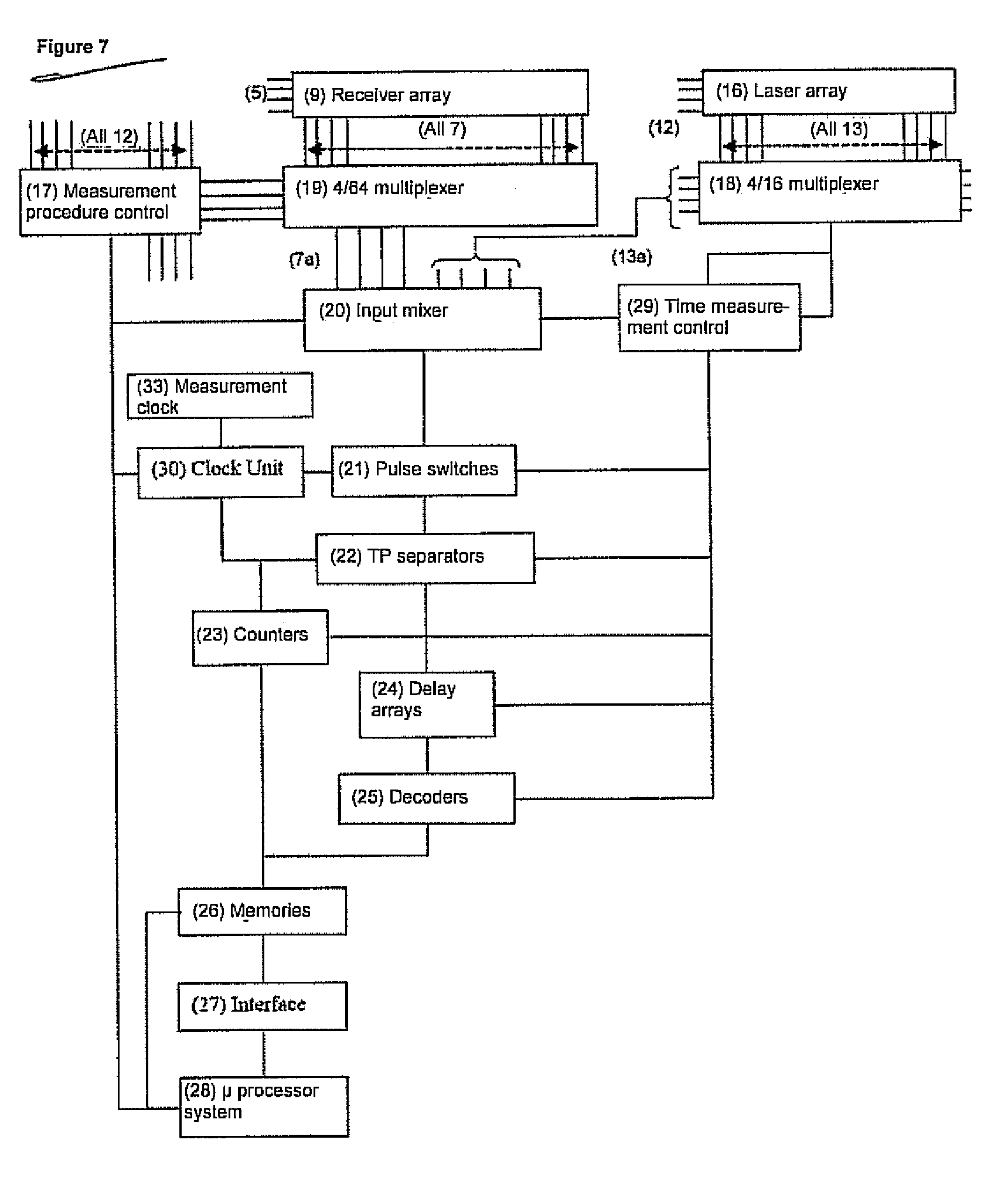The time measurement circuits or parts thereof are configured in a number of cases as an integrated “time measurement IC” due to the required switching speeds and complexity.
Existing sensors are generally limited in their speed of taking the measured value by the maximum pulse repetition rate of the
laser modules used.
This is very slow in comparison with purely imaging sensors such as CCD cameras and is not suitable for the detection of dynamic processes within the spatial angle taken.
However, the technical effort is enormous because the conversion rate has to be at some GHz and the computing effort for the averaging is necessarily proportional thereto.
For this reason, sensors of this type have not achieved any importance in the market so that the
sensitivity limit of today's pulse TOF sensors is generally larger than / equal to 4.5 NEP.
It is therefore a
disadvantage of the prior art thatthe sensitivity (minimal
signal-to-
noise ratio) is limited to larger than / equal to 4.5 NEP since no
noise pulses may be detected because they would be confusable with echo pulses and would falsify the result;only one echo pulse, in rare cases two echo pulses, can be processed during the TOF and so reflections from rain,
snow,
fog or from the dirty termination glass of the sensor or from a plurality of impacted targets cannot be evaluated within a TOF or even make the measurement impossible, so that external applications for pulse TOF sensors can only be realized with great limitations;no
parallel processing of a plurality of
signal pulses or parts of a
signal pulse is possible;no larger number of pulses such as
noise pulses which generally occur increasedly at a low selection of the
comparator threshold during the TOP can be measured with existing time measurement circuits;no 2D distance image taking (profile) is possible without a
scanner with movable mirrors;a 3D distance image talking is only possible with two scanners with movable mirrors;no sufficient speed for a 2D or a 3D distance image talking can be achieved.
Only very small ranges can be achieved with these sensors with a very large power and averaging effort so that they represent a poor compromise for all demands, with the exception of the
lateral resolution.
However, it takes considerably more effort to take the distance information as digital values from one or two images taken stereoscopically, and the accuracy worsens as the distance from the imaged objects increases.
With existing sensors, the measuring speed is generally limited by the maximum pulse repetition rate of the
laser modules used.
Furthermore, the mechanical strain on the mirror scanners is very high because the total number of deflections per second is equal to the product of the column and line numbers and the repetition rate of the distance image.
Generally, this is well above the mean repetition rate of the transmitters used so that existing sensors are not suitable for the taking of distance images for the named reasons alone.
It is problematic with the pulse TOF sensors known today that one or more of the following disadvantages and of the disadvantages already mentioned above is present in all sensors or measuring systems in existence today, namely that:no sufficient speed for a 2D and 3D taking of distance images can be achieved, or at best only in very slow operation;the mirror scanners are exposed to a high mechanical strain;the suitability for outside applications is very limited.
These systems suffer from a high calculation effort and from an error which increases considerably with the distance so that they only appear suitable in a very restricted application area;
triangulation systems in which a
laser line is scanned over an object and is measured by means of a
CCD camera.
These systems have a low range and a measurement error which increases with the distance;
radar systems with which e.g. aircraft in space are measured for the purpose of
air traffic control or tracking or ships are measured at sea for purposes of
position tracking.
These systems are, however, also only limited in their application to these cases due to the low
radiation frequency used, which causes a low
lateral resolution, and due to the long
time of flight of the signals, so that practically no further applications have resulted.
 Login to View More
Login to View More  Login to View More
Login to View More 


